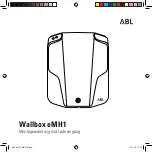
battery acid thoroughly with plenty of clean
water and seek medical attention at once.
H
Environmental note
Batteries contain pollutants.
It is illegal to dispose of them
with the household rubbish.
They must be collected sep-
arately and disposed of in an
environmentally responsible
recycling system.
Dispose of batteries in an
environmentally responsible
manner. Take discharged
batteries to a qualified spe-
cialist workshop or to a col-
lection point for used batter-
ies.
If the 12 volt battery has to be connected, con-
tact a qualified specialist workshop. Observe
the safety notes and protective measures when
handling batteries.
Risk of explosion. Explosive oxyhy-
drogen is produced when batteries
are being charged. Only charge bat-
teries in well-ventilated areas.
Fire, naked flames and smoking are
prohibited when handling the bat-
tery. Avoid creating sparks.
Battery acid is caustic. Avoid con-
tact with the skin, eyes or clothing.
Wear acid-resistant protective
gloves. If skin or clothes are
splashed with acid, neutralise the
splashes immediately with soapy
water or an acid neutraliser, then
clean the affected areas with water.
Consult a doctor if necessary.
Wear eye protection. When mixing
water and acid, the liquid may
splash into your eyes. Rinse acid
splashes to the eyes immediately
with clean water and consult a doc-
tor immediately.
Keep children at a safe distance.
Children are not able to assess the
dangers posed by batteries and
acid.
When handling batteries, observe
the safety notes, protective meas-
ures and procedures contained in
the Operating Instructions.
If you do not use the vehicle for a long period:
R
connect the battery to a Mercedes-Benz rec-
ommended charger.
or
R
contact a qualified specialist workshop to dis-
connect the battery.
Jump-starting and charging the 12 V
battery
X
Always use the jump-starting connection
point in the engine compartment when charg-
ing the battery and jump-starting.
G
WARNING
During the charging process, a battery produ-
ces hydrogen gas. If a short circuit occurs or
sparks are created, the hydrogen gas can
ignite. There is a risk of an explosion.
R
Make sure that the positive terminal of a
connected battery does not come into con-
tact with vehicle parts.
R
Never place metal objects or tools on a bat-
tery.
R
It is important that you observe the descri-
bed order of the battery terminals when
connecting and disconnecting a battery.
R
When jump-starting, make sure that the
battery poles with identical polarity are
connected.
R
It is particularly important to observe the
described order when connecting and dis-
connecting the jump leads.
R
Never connect or disconnect the battery
terminals while the engine is running.
G
WARNING
During charging and jump-starting, explosive
gases can escape from the battery. There is a
risk of an explosion.
Battery
203
Breakd
own
assista
nce
Z
















































